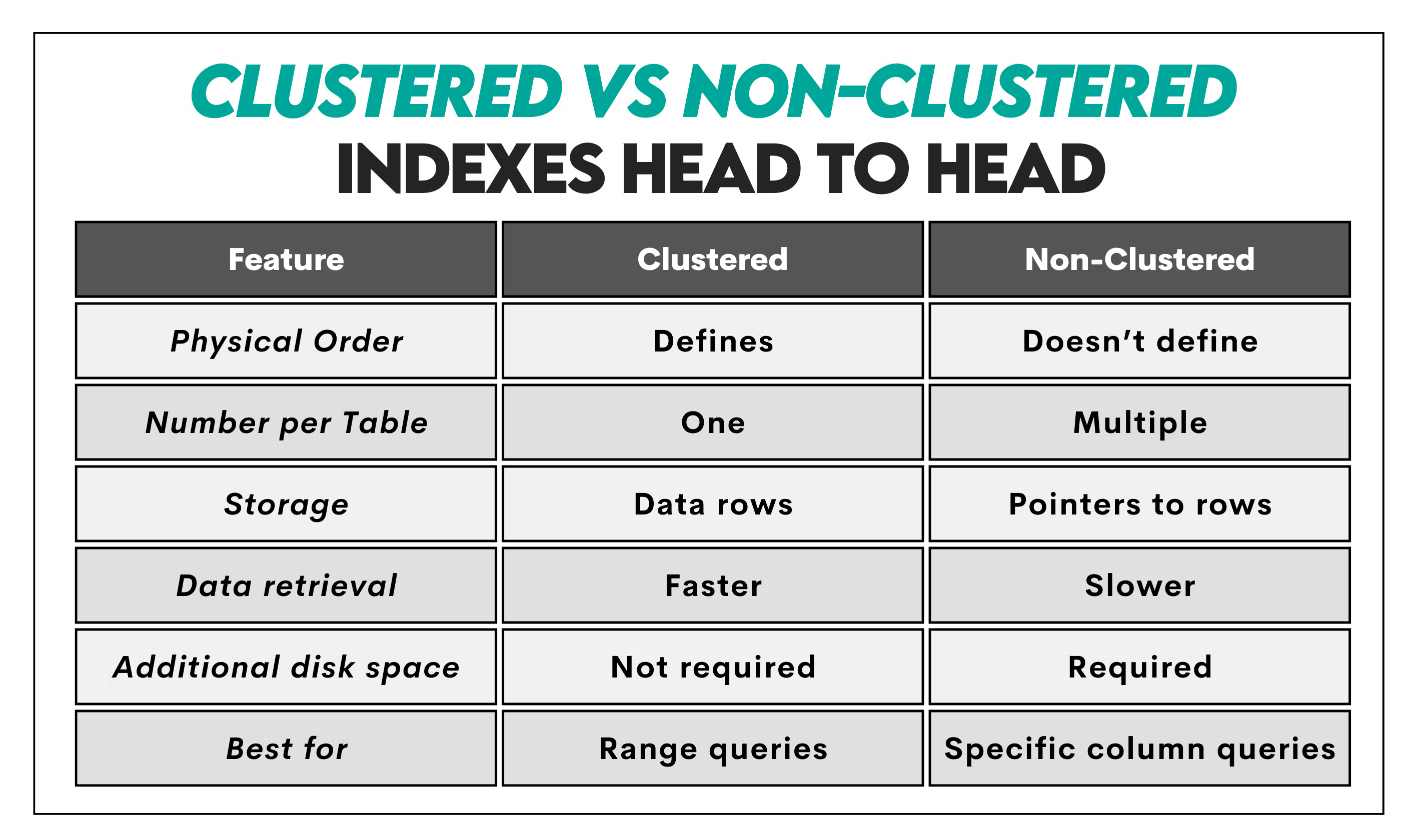
- Introduction to SQL Indexing
- Types of Indexes in SQL
- How SQL Indexes Improve Performance
- Creating an Index in SQL
- Clustered vs. Non-Clustered Indexes
- Unique and Composite Indexes
- How to Optimize SQL Indexes
- Disadvantages of Using Indexes
- Dropping and Modifying Indexes in SQL
- Indexing Best Practices
- Real-World Examples of SQL Index Usage
Introduction to SQL Indexing
In SQL, indexing is a powerful technique to enhance the speed of data retrieval operations in a database. An index is a data structure that improves the speed of operations such as SELECT queries, UPDATEs, and DELETEs by allowing the database to find rows more efficiently. Without indexes, the database engine would need to perform a full table scan for queries, which can be slow, especially when dealing with large datasets. Indexes are most valuable when querying large tables, where the speed of data retrieval is critical. They provide a way for the database management system (DBMS) to quickly locate data without scanning every table row. You can significantly improve query performance by creating indexes on the columns frequently used in SELECT queries (especially those in WHERE, ORDER BY, and JOIN clauses). Learn more with our Data science training.
Types of Indexes in SQL
SQL databases support different types of indexes, each serving specific needs based on query patterns and database structure. The main Types Of SQL Indexes include
- Single-Column Index: An index created on a table’s single column. This is the most basic form of indexing and is most useful when queries commonly involve filtering or sorting based on one column.
- Composite Index: An index created on two or more columns in a table. This index type is beneficial for queries that simultaneously filter or sort on multiple columns. Composite indexes can perform better when queries include various conditions in the WHERE clause.
- Unique Index: An index that ensures the uniqueness of the column values. It is automatically created when you define a column as UNIQUE in SQL, ensuring that no two rows have the same value in that column.
- Full-Text Index: A unique index used for efficient full-text searches, which is often used to index large text fields (such as articles or product descriptions). Full-text indexes allow searching for words or phrases within the text efficiently rather than matching entire column values.
- Spatial Index: An index for geographic data types, such as points, polygons, or lines. This is useful for location-based data and allows for fast spatial queries like distance calculation or area containment.
- Clustered Index: A type of index where the data rows are physically stored in the order of the index. There can only be one clustered index per table, as the data rows can only be ordered one way.
- Non-Clustered Index: A type of index where the index is stored separately from the data rows. Non-clustered indexes have a reference to the location of the data rows, and multiple non-clustered indexes can be created on a table.
How SQL Indexes Improve Performance
SQL indexes significantly improve performance by allowing the DBMS to quickly locate rows based on indexed columns without performing a full table scan. Here’s how indexes improve performance:
- Faster Data Retrieval: Indexes organize data to allow more rapid access, making queries that search for specific data much quicker. Rather than scanning the entire table, the database can use the index to find the data more efficiently.
- Efficient Sorting: When queries include ORDER BY clauses, indexes can quickly sort data in the specified order, dramatically improving the performance of sorting operations.
- Optimized Joins: Indexes on columns involved in JOIN operations can speed up the process of matching rows between tables, reducing the time it takes to perform joins in relational queries.
- Faster Aggregations: Queries that involve aggregate functions such as COUNT(), AVG(), SUM(), etc., can benefit from indexes, mainly if they are applied to indexed columns. This allows for quicker computations.
- Reduction in Disk I/O: Indexes reduce the number of disk reads by decreasing the amount of data that needs to be scanned, which is a major contributor to query performance improvement.

Creating an Index in SQL
Creating an index in SQL is straightforward. The basic syntax for creating an index is as follows:
CREATE INDEX index_name ON table_name (column1, column2, …); Example:To create an index on the last_name column of a user table: CREATE INDEX idx_last_name ON users (last_name); If you want to create a composite index on both first_name and last_name, the syntax is
CREATE INDEX idx_name ON users (first_name, last_name); The database can also automatically create indexes when columns have constraints like Primary Key or UNIQUE.
Clustered vs. Non-Clustered Indexes
Based on how they store data, indexes are categorized into two major types: Clustered Indexes and Non-Clustered Indexes. If you’re interested in exploring these concepts further, especially in real-world applications, consider checking out this comprehensive Data science training program. Clustered Index- Data Storage: The rows of the table are physically stored in the order of the clustered index. Therefore, there is only one clustered index per table, as the data can only be arranged in one order.
- Performance: Since the data is stored in the index’s order, queries requiring sorting or range scans (such as BETWEEN) are faster.
- Example: A PRIMARY KEY constraint automatically creates a clustered index. Non-Clustered Index
- Data Storage: The non-clustered index is stored separately from the data rows. The index references the data rows but does not affect their physical storage order.
- Performance: Non-clustered indexes are generally used for faster lookups when queries don’t require data to be ordered. Multiple non-clustered indexes can exist on a table. Example: An index created on the last_name column would be a non-clustered index.
- Use indexes on frequently queried columns: Focus on indexing columns commonly used in WHERE, JOIN, or ORDER BY clauses.
- Avoid excessive indexing: While indexes improve read performance, they can slow down INSERT, UPDATE, and DELETE operations. Only create indexes that are necessary for your queries.
- Update statistics regularly: Database statistics help the query optimizer make informed decisions. Ensure that your database statistics are up-to-date.
- Consider composite indexes: If queries frequently involve multiple columns in their filtering conditions, a composite index may be more efficient than creating multiple single-column indexes.
- Rebuild or reorganize indexes: Indexes can become fragmented over time. Rebuilding or reorganizing them can improve query performance.
- Increased Storage Requirements: Indexes consume disk space. Each index on a table requires additional storage, and large databases with many indexes can require significant space.
- Slower Data Modification: Indexes can slow down INSERT, UPDATE, and DELETE operations because the index must be updated whenever data in the indexed column(s) changes.
- Complexity in Maintenance: Managing indexes requires careful attention. Their effectiveness should be periodically reviewed as the database grows or query patterns change.
- Use indexes selectively: Index only those frequently used columns in query conditions or sorting.
- Regularly review and optimize: As query patterns evolve, periodically review your indexes to ensure they still provide performance benefits.
- Use compound indexes for complex queries: A composite index can speed up query execution for queries involving multiple columns.
- Consider the impact on write operations: Remember that indexes. Slow down INSERT, UPDATE, and DELETE operations. Use them carefully when dealing with heavy writing workloads.
- Monitor index usage: Most database management systems provide tools to monitor index usage and identify unused or inefficient indexes.
- Monitor index usage: Monitor index activity in both MongoDB Vs MySQL to identify and remove unused or inefficient indexes.
- E-commerce Websites: In an online store, queries that search for products based on category or price are standard. Creating indexes on columns like category_id, price, and product_name can significantly speed up these queries.
- Social Media Platforms: On social media platforms, creating indexes on columns like user_id and post_id can speed up queries that retrieve a user’s posts or check for the existence of specific posts.
- Financial Applications: In banking systems, indexes on account numbers, transaction IDs, and timestamps can help quickly retrieve transaction records or check balances.

Unique and Composite Indexes
Unique IndexA unique index ensures that no two rows in the table have the same value in the indexed column(s). It is used to enforce the uniqueness of the data in a column, such as when creating a primary key or unique constraint.
Example of creating a unique index: CREATE UNIQUE INDEX idx_email ON users (email);
Composite IndexA composite index includes more than one column. This type of index is useful when queries filter or sort based on multiple columns. The order of the columns in a composite index matters, as it optimizes queries that use the indexed columns in the same order as they are listed in the index. Example of creating a composite index: Data science training
CREATE INDEX idx_name ON users (first_name, last_name); Full-Text Indexing in SQLFull-text indexing is a unique indexing designed for efficiently searching and querying large amounts of text. This is particularly useful for columns that contain extensive text data (e.g., product descriptions, blog posts, etc.).
Full-Text Index in SQL ServerTo create a full-text index in SQL Server: CREATE FULLTEXT INDEX ON articles (content) KEY INDEX pk_article_id; Once the full-text index is created, you can perform full-text searches using the CONTAINS or FREETEXT functions. Example query: SELECT * FROM articles WHERE CONTAINS(content, ‘database’); This allows you to search for specific words or phrases within large text columns more efficiently than a traditional index.
How to Optimize SQL Indexes
Optimizing SQL indexes is crucial for maintaining performance as your database grows. Here are some tips for optimizing indexes:
Disadvantages of Using Indexes
While indexes offer numerous benefits, there are some downsides to consider:
Dropping and Modifying Indexes in SQL
If an index is no longer needed or is causing performance issues, you can drop it. Here’s how to drop an index in SQL:
DROP INDEX index_name ON table_name;
To modify an index, you must drop the existing index and create a new one with the desired properties.
Here are some best practices for working with indexes in SQL Applying these techniques and considerations can significantly improve the performance of SQL databases, ensuring fast data retrieval, efficient queries, and optimal resource use.
Indexing Best Practices
Real-World Examples of SQL Index Usage

